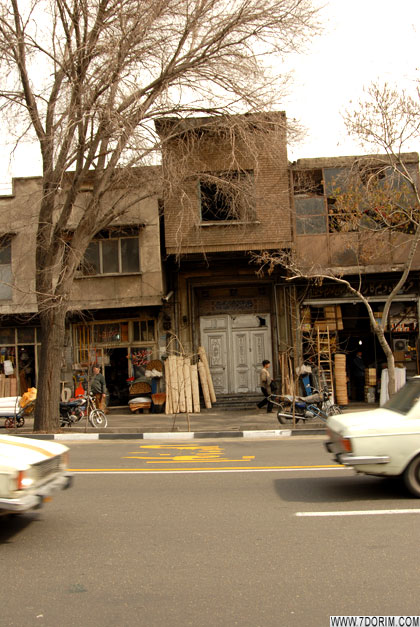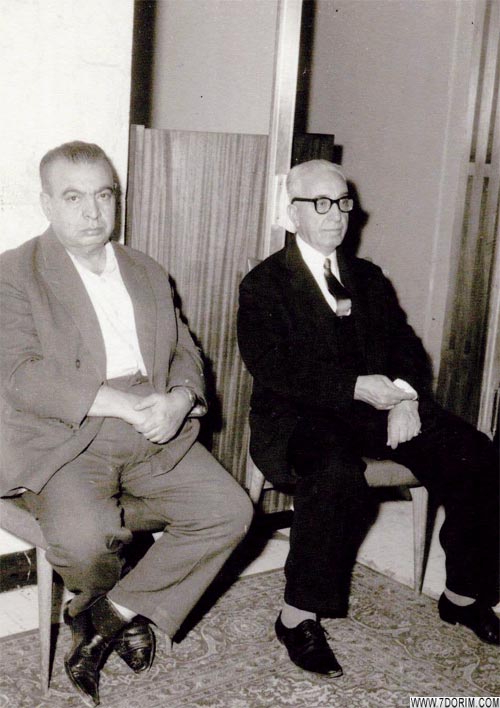
Click here for a 3D-view of the Keshvaiyeh traditional public bathhouse

Bearer of valuables, listen to this call,
Leave them safe here, safe from all.
Unless you’re the type that if a bad thing befalls,
Refuses that the bathhouse holds no blame at all.
Public Bathhouses of Oudlajan, the Sar Chal area
About a century ago, in the Oudlajan neighborhood of the Sar Chal area, Jewish residents had three baths exclusive to themselves. One, known as the Esav Bathhouse. Another, the Zekhron Bathhouse, by the Oudlajan Bazaar, adjacent to the Esghagh Yaghoub (i.e. Ezra Yaakov) Synagogue. The third, the Hakim Bashi or Eshagh (i.e. Isaac) Bathhouse, which resided within the Tekieh of Reza Gholi Khan.
During that era in Tehran, particularly in Oudlajan, the lack or scarcity of water pipes compelled citizens to rely on wells or cisterns (i.e. underground canals) for their water needs. As a result, the prevalent baths were situated underground, some 12 meters beneath ground level, adjacent to the cisterns. Accessing these baths required descending roughly 40 to 50 steps from the surface. Needless to say, this sharp descent proved challenging for the elderly, expectant mothers, and children, often leading to accidents.
To fill the baths with water, the flow from the cistern first filled reservoirs known as “Ab Anbar” (i.e. water tanks) before entering a pool, or khazineh, for warming. These khazinehs typically featured sarooj-lined interiors, which was a mixture of lime, egg whites, and ash. A portion of their base was crafted from copper for rapid heating. The heated water was dispensed through one or two taps, with additional vessels known as “Meshrabeh” positioned along the khazineh’s perimeter. Heating the water in the khazinehs required a furnace beneath, which was fueled by wood and astragalus (a desert thorn). Later mazut (a low-quality heavy fuel oil) was used as fuel.
As for illumination, each bath incorporated 50-centimeter-high protrusions on the roof, resembling half-domes or polygonal structures, part of which comprised glass for skylights. Sunlight refracted through these glasses, enhancing interior brightness. During dusk or cloudy weather, oil-fueled lanterns or lamps were strategically placed within the bath. Furthermore, the bath’s inner walls were coated with lime to maximize light reflection since it was white.
These baths were communal spaces, accommodating an average of 30 to 50 people. Typically, they served men in the mornings and women in the afternoons.

Keshvariyeh Public Bath, 1990s, Seen standing: Fatima Shanbeh-joo, bath worker
Image taken from the archive of Ketab-e Aval website
Keshvariyeh Public Bath: 1942
In 1942, during a funeral ceremony at Behesht-e Zahra in Tehran, Mr. Soleiman Seneh, the husband of the late Keshvar Khodad, addressed the audience. He expressed gratitude to friends and relatives for their presence. He told them that one of his wife’s wishes was to establish a modern bathhouse in the Sarcheshmeh neighborhood. He urged everyone to join hands in fulfilling this wish, offering 50,000 tomans of initial capital and inviting others to contribute according to their means.
His plea received no cooperation. Undeterred, Soleiman Seneh, son of Elazar, took it upon himself to fund the project. He worked in currency exchange and was a shareholder in the Aragh Meikadeh factory. Soleiman purchased houses on Cyrus Street from Mrs. Tala Daneshrad and Mr. Rahman Ghasab and began construction in 1945.
The bathhouse received water from Haji Alireza’s cistern and stored it in its own cistern, below the bathhouse. A pump transferred this water to a trunk on the roof. Pipes from the trunk transferred separated hot and cold water to the rest of the bathhouse.
At the beginning, Suleiman Seneh was forced to take an extra 180,000 toman loan from the private sector to speed up construction. The bathhouse was opened in early winter of 1947. Its exceptional design and facilities quickly earned it a reputation, drawing visitors from across Tehran and towns beyond.
The bathhouse had modern amenities, including two public baths for men and women with a capacity of 40-50 people, in addition to eight private baths with showers and European-style dressing rooms. Its design blended Eastern and Western influences, with features like green marble floors and walls, a marble pool at the bathhouse entrance with a beautiful water-feature, plasterwork, mirror-works on the ceiling and some walls, marquetry doors — especially the entrance door, well-designed skylights on the ceiling, colored windows over the doors, and decorative tilework that not only enhanced the beauty of the bathhouse, but also that of Cyrus Street.

Image of Suleiman Seneh and his wife, Keshvar Khodad, photographed in 2009.
Suleiman Seneh succumbed to an illness and died at the age of 77 in 1980. Following his death, the Keshvariyeh bathhouse was closed after 31 years of operation. Since Suleiman had no heirs, the bathhouse was legally transferred to the Tehran Jewish Committee’s authority. The Committee spent some time repairing and reconstructing the bathhouse, until it was reopened in 1982, this time under the management of Noorollah Derakhshan, who had volunteered for the position.
As Jewish residents of the Sar Chal area moved to other places and fewer people visited the bathhouse, the Keshvarieh bathhouse reduced its activity to two days a week — Thursdays and Fridays. The bathhouse was completely closed down a year later. Due to its impressive façade and unique architecture, the bathhouse was registered under the protection of the Cultural Heritage Organization of Iran.
Despite the passing of years and the closing of the bath, there are still customers who ask for Fatemeh Khanum and the treasure water of the Kashoriyeh bath.

The Keshvarieh Bathhouse as seen from Cyrus Street.
Photographed in 2009.

The bathhouse entrance.

The façade of the main entrance of the bathhouse.
Suleimanieh for men — Keshvarieh for women.

A picture of the ceiling and entrance of the bathhouse.
Suleimanieh for men — Keshvarieh for women.

Certificate of the bathhouse.
Photographed in 2009.

Noorollah Derakhshan, manager of the Keshvarieh bathhouse from 1982 – 2002.
Photographed in 2009

Door of the waiting hall and the doors of the men’s and women’s bathhouse.
Photographed in 2009

Men’s bathhouse entrance door and the door that leads to the engine room, the entrance door to the women’s bathhouse.
Photographed in 2009

Left: Entrance door to the men’s bathhouse; Right: Door that leads to the engine room and the entrance door to the women’s bathhouse.
Photographed in 2009.

Ceiling of the waiting hall and its skylight.
Photographed in 2009.

Another view of the ceiling of the waiting hall and its skylight.
Photographed in 2009.

Entrance door of the women’s private bathhouse.
Photographed in 2009.

Interior view of the private bathhouse.
Photographed in 2009.

Interior view of the private bathhouse.
Photographed in 2009.

Interior view of the dressing room and private bathhouse.
Photographed in 2009.

Corridor of the private baths (right door is the toilet and left door is the workers’ dressing room).
Photographed in 2009.

Corridor of the private baths from another angle.
Photographed in 2009.

Dressing room section in the women’s public bath.
Photographed in 2009.

Dressing room section in the men’s public bath.
Photographed in 2009.

Shower section in the men’s public bath.
Photographed in 2009.

Skylights in the men’s public bath.
Photographed in 2009.

View of the skylights in the men’s public bath from the roof.
Photographed in 1986.

View of the corridor and the pool.
Photographed in 2009.

View of the entrance door of the bathhouse.
Photographed in 2009.

Part of the plasterwork and mirror work on the wall of the bathhouse.
Photographed in 2009

Left: Soleiman Seneh, founder of the Keshvarieh Bathhouse, Right: Aghajan Abrishami, founder of the Abrishami Synagogue.
Photographed in 1961.

Mosaffah Public Bathhouse in Nowrooz-khan (previously known as Eshagh).
Photographed in 2009.
The Eshagh Bathhouse:
In front of Haji’s shop, an alley stretched to the east, towards the Razagholi Khan Tekieh and Cyrus Street. There was a bathhouse in the middle of this alley, before the Tekieh. It was called the Eshagh Bathhouse, which was frequented by the relatively wealthy Jewish class.
Back in those days, entry to bathhouses required a descent of about fifteen or twenty steps to the basement. Once inside the Eshagh bathhouse, they would enter a public dressing room with platforms around it for sitting. People would enter with a bundle, a bath bowl, and a small basin, and take off their clothes in the changing room. They could hang their clothes on the wall. They would enter the bathhouse hall while covering their private parts with a peshtemal (a traditional towel). They would carry a bath bowl and a bag containing a few pumice stones, a washing mitt, soap, a comb, and some other things.
There were two pools on each side of the bathhouse hall, one hot and one cold. These pools were connected to the bathhouse with a special faucet, and each person would take some water from both of them and sit in a corner of the bathhouse with their companions, who were often a few children, and start scrubbing their hands and feet with pumice and their washing mitts.
The next step after this was to summon a [specialized] bath attendant, who would scrub the children and apply soap. The children would then go to the dressing room, one by one or together, and put on their clothes and leave.
These bathhouses worked in two shifts: in the early morning from 4 a.m. with the sound of the rooster crowing until 8 a.m. for the men, and the rest of the day for women.
Bathhouses could generally accommodate only fifteen or twenty people, but on holidays and special occasions, they would accept twice or three times their capacity. Bath water would run out and people would have to climb over each other’s heads and compete for some hot and/or cold water. Eventually, their day at the bathhouse would end with half-washed bodies. This happened especially a day or two before Yom Kippur, when everyone wanted to prepare for the special day. The latter caused a true uproar in both the women’s and men’s bathhouses.
To prevent hot water shortages, the bathhouse owner would try to produce more hot water. As a result, the temperature within the bathhouse hall soared too, and everyone would try to leave the bathhouse and its excessive heat as soon as possible. The bathhouse attendant welcomed this scenario as it meant increased customer turnover.
Sometimes, some people, received deliveries from their homes, which normally included watermelons, melons, or — in hot seasons of the year — beverages with ice. For those who did not receive deliveries, especially us kids, our only share of those deliveries was to watch with envy — since, considering the heat of the bathhouse, what could be more appealing and desirable than those delicious cold beverages or fruits?
From the notes of Jahangir Banayan

Click here for a 3D-view of the Keshvaiyeh traditional public bathhouse


 فارسی
فارسی